Alocasia is sometimes known as the Kris Plant, Elephant Ear or African mask plant. This unusual looking houseplant will produce flowers on occasion, but it's not brought for this reason. When it comes to an Alocasia purchase it's all about the unusual and unique alien looking leaves.
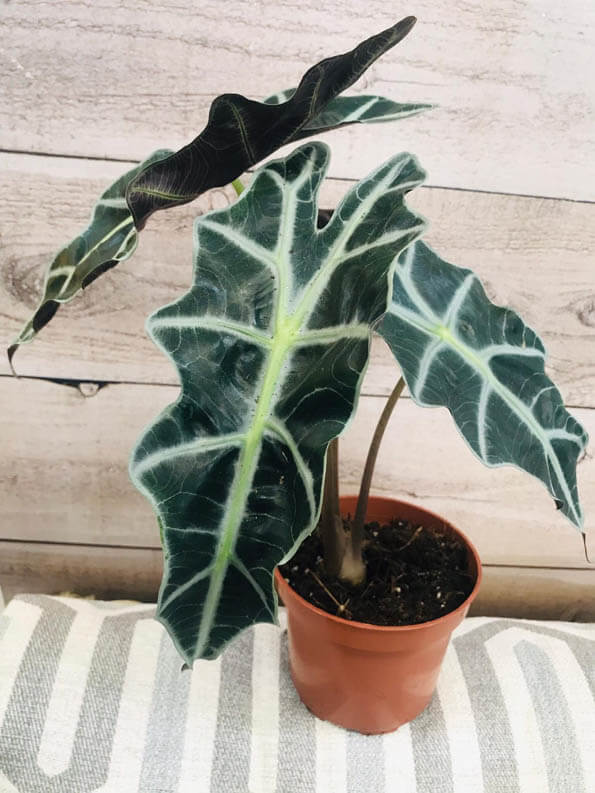
A. amazonica
The impressive and stunning leaves are arrowhead or shield shaped with large protruding white veins running through them which contrasts strongly with the rest of the dark green leaf.
This houseplant is all about the unusual and unique alien looking leaves
Alocasia is the species and there are many varieties and hybrids, however the main one grown as a houseplant is "Polly" or "Amazonica" (A. amazonica)
Some people will argue that "Polly" and "Amazonica" are very different varieties or hybrids and "Polly" is the easier one to grow as a houseplant , although this isn't really true. At least scientifically. "Amazonica" was the original and is believed to have started appearing in homes in the 1950s, a few years later along came "Poly" (groan), when a smaller variation of "Amazonica" was found.
The name "Poly" was changed to "Polly" when the plant's appeal increased and started to be sold as a houseplant for commercial (and obvious) marketing reasons by nurserymen. Should you actually try to grow the two plants side by side the only difference you will find is "Polly" tends to be smaller than "Amazonica".
How do you pronounce Alocasia correctly? Say: al-lo-KAY-zee-uh
As mentioned already A. amazonica is the most commonly found plant on offer when it comes to this species (shown in the photo at the top of the article). Although within the last five years a number of interesting Alocasia varieties have started to gain significant popularity and are becoming more common in shops. Let's take a quick look at two varieties that are well liked and very easy going (we'd even go as far as saying they're less fussy than A. amazonica!).
However do bear in mind that these newer plants can be difficult to find and very expensive to buy. Alocasia plants in general are not recommended for the beginner so do think carefully before spending big bucks on one of these houseplants because they might not last very long if the care provided isn't right. That said, anyone with a bit of houseplant experience (and the right growing conditions) should be perfectly fine with these beauties.
A. zebrina has the familiar arrowhead or shield shaped leaves, but the "veins" have gone. The leaves are also a slightly paler green and aren't as thick. In return you're given a much taller and slender looking plant, where the stems are vivid and have a pattern similar to a Zebra (hence the name).
There are several cultivars which either have different colour stems or different leaf markings. However you'll know if you have a Zebrina because the leaf shape remains constant i.e. arrowhead shaped without the white veins running over the surface.
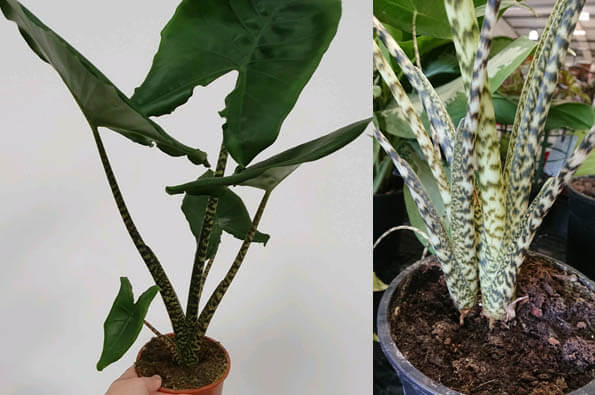
A. zebrina
A. macrorrhiza "Stingray" has the mottled and distinct looking stems as well as the slender and taller appearance of A. zebrina . However it looses both the arrowhead shaped leaves and the "veins" of A. amazonica.
Instead they're replaced by a leaf shape that looks like a Stingray with the fish like wings and long tail. Like it's cousins it's truly a plant that has to be seen to be believed. Without doubt Alocasia plants belong to one of the most unusual and quirky family of plants.
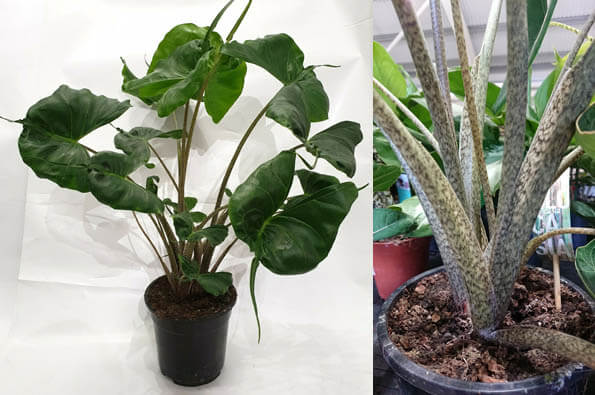
A. macrorrhiza "Stingray"
Under ideal circumstances there would probably be more Alocasia fans. The problem with these houseplants, is that they can be quite difficult to keep alive as it won't accept sub standard care or incorrect conditions for very long.
Consequently the plant inevitable dies in a spectacular failure and the owner doesn't try to grow them again or recommend it to anyone.
Another issue is that some plants (if permitted to) enter into a dormant state and will die back during Winter. Although it normally comes back in Spring it can disappoint people to have a houseplant which is not "there" for the whole year. Both of these issues can be dealt with and we are going to tell you how.
So if your attention is grabbed when you walk past an Alocasia, you like the look of it and you think you can provide the care requirements detailed below, don't be afraid to get one!

Hi, I'm Tom!
If you're like me and enjoy the challenge of growing houseplants and getting them to thrive, then Ourhouseplants can help. This website shares my knowledge and years of growing plants and provides (hopefully) helpful advice on properly caring for your indoor plant friends.
Alocasia can be quite difficult to keep alive as it will not accept sub standard care or incorrect conditions for very long
You must avoid both direct harsh Sunlight and very dark and gloomy spots for your plant. Locations which fall between these two extremes are required. A. amazonica struggles with prolonged exposure to sunlight however, in our experience, both A. zebrina and A. macrorrhiza cope much better with some morning or late afternoon sun falling on their leaves.
When in active growth the compost must be kept moist at all times. That's moist, not dry or soggy. The Kris Plant dislikes dryness at the roots, but too much water will cause the roots to rot.
Unlike conventional houseplant watering wisdom we've found the best approach is to water little but often. If you can, make an effort to use tepid rain water but it's not essential.
Another reason for this plant failing spectacularly in a home environment is because of very dry air. It's a tropical plant and needs reasonable, or high humidity. If you suffer from dry air have a look at our Humidity guide for ideas as the Alocasia is not adaptable to this requirement.
A weak all purpose feed once a month is more than sufficient. Don't bother in Winter unless the plant is still activity growing, i.e. new leaves are appearing. Definitely do not feed if your Alocasia enters a die back type of dormancy (see Anything else below).
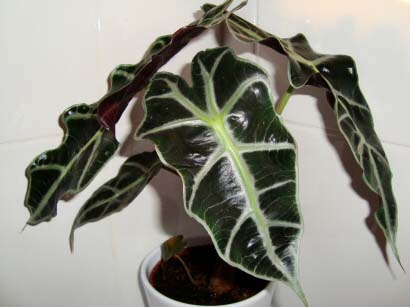
It needs a warm spot. No lower than 16 °C (61°F) all year round. Occasional dips below this will be tolerated but longer periods will cause problems and encourage dormancy.
This is not normally needed, but if your plant has produced lots of offsets or it has outgrown its pot it's a good idea to repot in Spring. Although they look like tropical and very particular plants, it's fine to use a standard houseplant compost or mix.
You can remove any Elephant Ear offsets when you repot. The adult plant will forgive an Autumn/Fall standard repotting, but if you are repotting because you want to propagate the offsets at the same time, do it in Spring to increase your chances of them surviving.
All you need to do is gently remove the offset along with some of it's roots before potting it up in a pot containing a similar mix to what it was growing in before. You may need to take your time and gently unwind the roots if they've tangled up with the roots of the mother plant. Do not fertilize new plants created like this for at least three months.
Expect a moderate speed of growth when the days are long and the temperature warm, otherwise known as Summer. One new leaf each month is fairly normal, slightly less is also okay and not something to be worried out. If you've not have any new leaves in 6 months you may need to think about repotting or fertilizing (if you're not already).
A. amazonica will normally grow up to 45cm / 18in in both height and spreads when grown indoors. A. zebrina and A. macrorrhiza both have a taller and more slender stature, although they don't often grow taller than 75cm / 30in.
Although flowers appear once in a while on a well looked after Alocasia, they are quite insignificant. The focus of this plant should be maintaining its beautiful foliage.
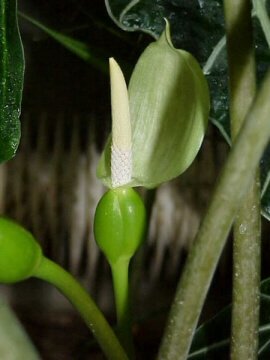
The plant is toxic to people and pets because of the calcium oxalate crystals found in the plant's sap. However this is more of a defense mechanism and consuming the plant tends to result in unpleasant side effects and is rarely fatal.
Some Alocasia's will enter a die back dormancy if a combination of shorter days with cooler temperatures occurs. You may be able to avoid this if the plant is moved to a warmer spot as Winter approaches.
If it enters dormancy anyway don't panic, all you have to do is follow the same care guides for a growing one. The only difference is much less watering and no feeding until new shoots come back in Spring.
Average Light This is a strictly down the middle plant. No intense direct sunlight, but also no deep shade.
Average Watering These plants don't like to dry out so aim to keep the soil moist during the growing months.
Warm Temperature Warm temperatures are preferred. Not lower than 16°C (61°F).
Average Feeding Alocasia plants grow slowly and are not too fussy about feed so once a month (or less) is fine.
Spider Mites / Scale / Mealybugs / Aphids
Alocasia is poisonous to people, cats, dogs etc, but rather tasty and can make a good home for a lot of pests! Most of these bugs can be put off by keeping humidity high.
Brown leaves with yellow markings
If the leaves are looking like the one in the photo below then it's likely due to one of the following:
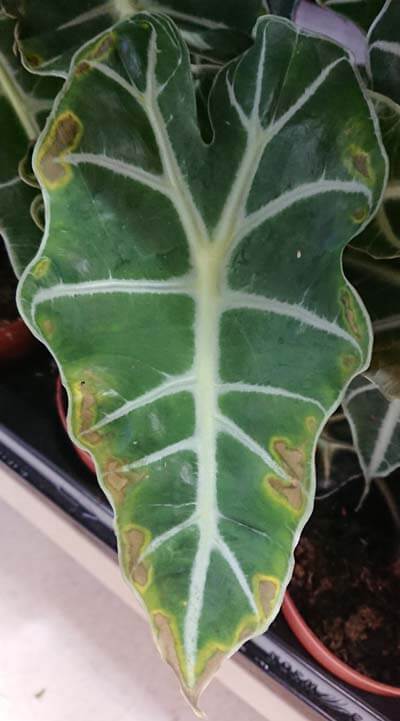
Dry crispy Alocasia leaves
This is normally a sign that the humidity surrounding the plant is too low. They love warm spots in your home but they also need a certain level of moisture in the air. Some people advise misting the plant which likely will help in the short term, but you'll need to do it daily. If this is too much work then try some of the more conventional ways of achieving this for a more permanent solution.
Pale / patchy brown leaves
Too much light usually caused by direct sunlight, or moving the plant from a dark to very bright spot too quickly.
My Alocasia plant is dying
If the plant has been healthy all year but in Winter everything is dying back, chances are yours is entering a normal die back dormancy. This means everything above the soil dies off. Keep caring for what will essentially look like an empty pot because the rhizomes below ground will still be alive. In Spring growth will shoot back up.
If the plant is dying back at any other time of the year then regrettably you have failed to accommodate its fussy nature. It you spot it early enough it's not too late, try and create conditions discussed in the care information above.
(Article / Gallery) Photo credit of the Alocasia flower to Kurt Stueber
(Gallery) Photo credit of the Alocasia with wide selection of leaves to Kurt Stueber